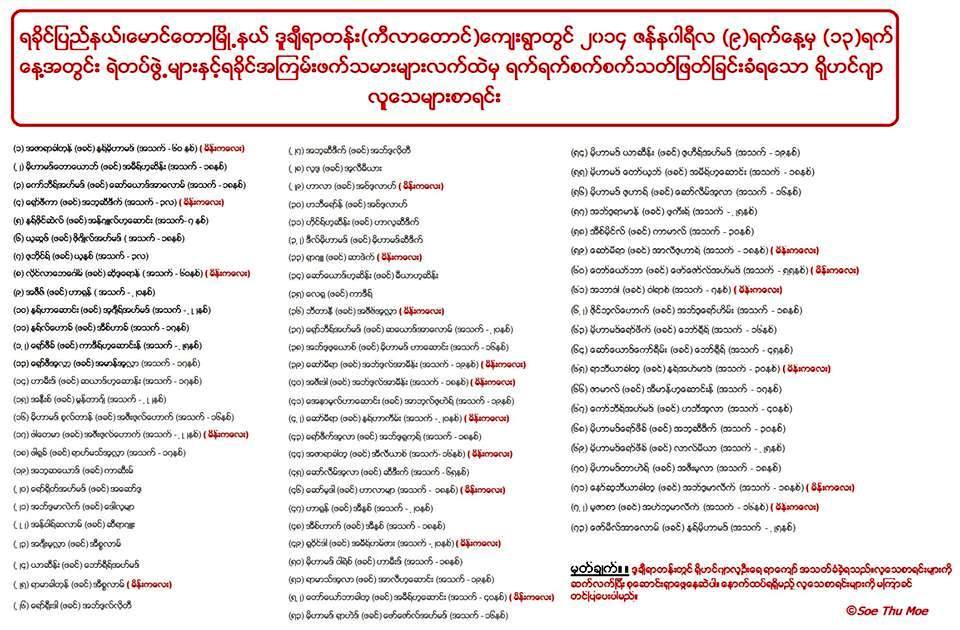By Aman Ullah
Burma has been grappling with sectarian violence since June 2012. Since then, many Rohingya have been herded into miserable camps they are not allowed to leave, even for work. Of the 18 townships in Rakhine State, seven have already barred Muslims from using their clinics, foreign aid workers. Those who were allowed to live in villages like Du Chee Yar Tan are at the mercy of the local authorities, many of whom are inspired by an extremist Buddhist group whose monks have used the nation’s new freedoms to travel the countryside on motorbikes preaching hatred of Muslims.
A deadliest attacked was occurred in January 2014 in Du Chee Yar Tan, a village in Maungdaw Township of northern Rakhine state, appears to be the deadliest in a year. Attacks began Jan. 9 and peaked in the early hours of Jan. 14, according to residents.
On January 9, 2014, Rakhine villagers attacked and killed 8 Rohingya in the Du Chee Yar Tan village and on January 13, the Rohingya of that village captured and killed a police sergeant. Seeking retaliation for the abduction and killing of a police officer by Rohingya villagers, Buddhist Rakhine mobs entered under the cloak of darkness with knives, sticks and guns and went on a killing spree, residents in the area. Many of the victims were women and children, hacked to death by the mobs.
Many villagers fled after the attacks. The authorities have prevented the media from going to the area, making reporting difficult. The situation around Du Chee Yar Tan remains tense. Reports received by Human Rights Watch say that police authorities have orally issued a blanket order permitting the arrest of all Rohingya men and boys over the age of 10 in the area.
The humanitarian aid group Medecins Sans Frontieres, or Doctors Without Borders have said that they have treated 22 Rohingya patients, from the area who had gunshot, knife, and machete wounds. The United Nations has confirmed that at least 48 Muslims appear to have been killed in that Buddhist mobs attacked, a massacre that has been the vehemently denied by the government since it was first reported by The Associated Press just over a week ago.
The villagers’ accounts back up a United Nations investigation, which concluded that the attack on Du Chee Yar Tan that night resulted in the deaths of at least 40 men, women and children, one of the worst instances of violence against the country’s long-persecuted Rohingya Muslims. They were killed, the United Nations says, by local security forces and civilians of the rival Rakhine ethnic group, many of them adherents of an extreme Buddhist ideology who were angered by the kidnapping of a Rakhine policeman by some Rohingya men.
According to a statement on the Ministry of Information website, it said that,”false news published and aired by foreign media that children and women were killed in the violence.” The only mob attack that took place, he said, was by Rohingya villagers on the police sergeant. The country’s human rights commission called the news “unverifiable and unconfirmed.”
The world organization’s report — presented to the government by the United Nations and United States but not made public — documents the initial discovery of the massacre by five Muslim men who sneaked into the area after the attack. They found the severed heads of at least 10 Rohingya bobbing in a water tank. Some of those were children’s.
The United Nations, base its finding on interviews with a cross-section of witnesses, victims and local officials on the ground, confirmed that at least 48 people had been killed in two separate bouts of violence and a massacre had taken place.

More Stories
Dr Younus and UN Chief Push for Rohingya Repatriation
During a joint visit to the Rohingya refugee camps in Cox’s Bazar, Bangladesh’s interim government leader, Dr. Yunus, and UN...
NUG’s Silence on Rohingya Deaths in Maungdaw
The Rohingya community has expressed growing frustration and concern over the National Unity Government's (NUG) continued silence regarding the tragic...
Escalating Atrocities Against Rohingya in Maungdaw
This report provides a detailed analysis of the ongoing atrocities against Rohingya civilians in western Myanmar, particularly in Maungdaw, Arakan...
UN Warns of Another Rohingya Genocide Amid Twin Threats
The UN High Commissioner for Human Rights, Voler Turk, sounded warnings concerning a grave threat to the civilian population, specifically...
Bangladesh Border Guards Accused of Assaulting and Repatriating Rohingya Refugees
In February of last year, Fortify Rights, a human rights organization, reported that more than 300 Rohingya refugees were allegedly...
A legal briefing by The International Commission of Jurists (ICJ)
The International Commission of Jurists (ICJ) published a legal briefing on the hearing on provisional measures to be held at...